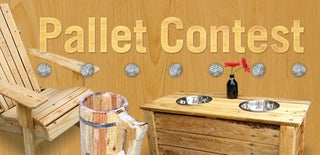Introduction: Wild Rabbit Feeder
I had two free range house rabbits for many years (seen above)... and they were awesome. Quiet and litter trained like a cat, but with the mannerisms of a dog. They had very pronounced personalities. Peanut (Tan) was a risk-taking adventurer .. climbing stairs (quickly blocked off), scaling the couch to the very top, speeding around corners to insert himself into the fridge every time he even thought it was going to open. Jetsyn (Black), Pea's Sister, was in charge ... usually more chill than Him, but with a devilish side .. she dug holes into the 6 month old couch for instance.
They would greet me in the morning, as well as every time I returned to the homestead .. quickly chinning every new arrival to claim ownership. If they deemed a visitor worthy, He/She might be welcomed to the family via grooming. Awesome ... expensive, especially in terms of medical treatments, but awesome nonetheless.
Since their passing and interment, there has been an increase of wild rabbits visiting the yard. Grazing on the garden, grass, clover, and even just stretching out, which is a sign of feeling secure/comfortable.
I have a surplus of hay ... I have a pallet ... might as well put them to use.
Step 1: The Pallet and the Panel
Ahhh .. the victim .. I mean pallet.
I removed the widest and best (no splits) boards in their entirety, but the rest I just cut out with a circular saw to avoid the headache of nail removal.
I cleaned up the edges on the three best boards and glued them up as a panel, which will serve as the back and top. Four large clamps for the panels and 6 smaller clamps for the cauls to keep everything aligned as much as possible.
Note: All of my measurements were arbitrary and on the fly. I'll list them at the end.
Step 2: Milling the Parts
To get a straight edge on one end of the back, I tacked on a guide with a pin nailer. Cut it long, removed the guide, flipped the panel, and cut to length. I then ripped an inch off each side to ensure the top overhung on both sides equally.
For the sides, I tacked two boards (cut to desired length) together with pin nails and cut a taper using a tapering sled. For the top angle, I used a miter saw.
I wanted the bottom to have some drainage during rain, so I laid out a rough grid and drilled holes on the drill press.
I decided to class up the tray with mitered edges, which I just cut to fit as I assembled.
Step 3: Carcass Assembly
Glue and pin nails to keep everything in place until cured. I started with the bottom, then the sides.
3/4" strips of pallet wood were cut to size used to form the gridwork which holds the hay. Wide enough for rabbit heads, yet close enough to provide support. Smaller pieces with close spacing create the bottom of this "basket."
Once that was in clamps, I added a french cleat to the back for easy installation.
Step 4: The Top
I visually decided on a length for the top, ensuring the top overlapped the attached cleat in the back. I then cut an angle on the back side, which matched the slope of the sides (around 15 degrees I think).
The top needed some alignment rails attached so it wouldn't just fall off. I used more 3/4" strips. Flipped everything upside down, centered the parts, glue and pin nails.
Step 5: Finishing
I decided to add a dedication,or memorial if you will, to Jetsyn and Peanut. This was done with a simple toner transfer method.
Create your image and print it as a mirror image (backwards). I use Photoshop, but you can use whatever software you have available. I aligned my text, fixed one side with tape, and used a Weller Woodburning kit to transfer my image. Note: Keep moving or you will get burning ... like I did. Good thing this is "rustic."
I knocked down all the sharp edges with 100 grit sandpaper and then brushed on a finish of 50/50 Boiled Linseed Oil/Mineral Spirits. Let it cure overnight.
Step 6: Installation
To install, all I had to do was screw the bottom side of the french cleat to a fence post, which will will come in handy in the event I need to relocate the feeder.
A 3" PVC cap serves as a water bowl. The tray can hold small amounts of pellets and/or vegetables, as well as catch falling hay.
Time will tell if the wild rabbits have any interest.
Part Dimensions:
Back: 13" width x 15 1/2" length
Lid: 14 7/8" wide x 12 7/8" length
Sides: 15 1/2" length. Top width of 5". Bottom width of 2". Top slope cut by eye .. around 15 degrees.
Tray: 5 1/2" width x 13" length
Tray Sides: 1 1/4" wide and cut to fit.

Participated in the
Great Outdoors Contest

Participated in the
Pallet Contest











